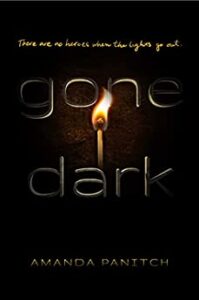Gone Dark
Amanda Panitch
Margaret K. McElderry Books
Published April 12, 2022
Amazon | Bookshop | Goodreads
About Gone Dark
When seventeen-year-old Zara escaped her father’s backwoods survivalist compound five years ago, she traded crossbows and skinning hides for electricity and video games…and tried to forget the tragedy that drove her away.
Until a malware attack on the United States electrical grids cuts off the entire country’s power.
In the wake of the disaster and the chaos that ensues, Zara is forced to call upon skills she thought she’d never use again—and her best bet to survive is to go back to the home she left behind. Drawing upon a resilience she didn’t know she had, Zara leads a growing group of friends on an epic journey across a crumbling country back to her father’s compound, where their only hope for salvation lies.
But with every step she takes, Zara wonders if she truly has what it takes to face her father and the secrets of her past, or if she’d be better off hiding in the dark.
DRY meets HATCHET in this thrilling tale of survival following a teen girl who must lead her friends across country to the safety of her estranged father’s survivalist compound after a mass power failure leaves the country in chaos.
My Review
One of the fascinating things about this book is Zara’s conflicted feelings about her dad. She and her mom escaped from his compound, and there’s obviously lots of trauma back there she’s not ready to unpack at the beginning of the book. Yet when the power grids go down, she decides his property is the safest place for her and her friends. I found that idea to be kind of hard to digest sometimes.
It made sense that she had conflicted feelings– he’s still her dad, and she was a child when she lived with him, so a lot of her memories about him are a little mixed up. Maybe what was hard to digest was the idea that Zara would be safe at her dad’s. So while she’s locked in on returning to him as a goal, I felt like that was definitely not going to go the way she hoped.
I don’t want to give anything away. I guess I can say that for the most part, I was satisfied about the way things went down. Not everything went the way I expected, which was okay. But it made sense, and felt like the story resolved for the most part.
I liked Zara’s character and her relationship with Gabe and the rest of her team. I loved the way each teammate brought something different to the group, and the way they learned to depend on one another. Another thing that I liked a lot was the mix of people they met along the way. Certainly there were people for whom the catastrophe brought out the worst in them. But there were a lot of people who were trying to be good people and trying to do good things in spite of a horrific situation.
All in all, I enjoyed GONE DARK. I loved that it’s from a girl’s perspective. It reminded me a little bit of ALONE by Megan E. Freeman.
Content Notes
Recommended for Ages 12 up.
Representation
Zara’s best friend and her brother are Latinx. One minor character is gay.
Profanity/Crude Language Content
None.
Romance/Sexual Content
Kissing between boy and girl. Description of a kiss between two boys.
Spiritual Content
Zara and Gabe stay on an LDS compound for a while.
Violent Content
Several scenes include brief graphic violence showing someone murdering someone else. At one point, a man drugs several others, intending to have them killed later.
Drug Content
Zara and her friends find a bottle of vodka and drink it together.
Note: This post contains affiliate links, which do not cost you anything to use, but which help support this blog. I received a free copy of GONE DARK in exchange for my honest review.
